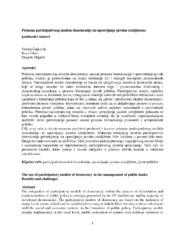Primena participativnog modela demokratije na upravljanje javnim zemljištem: prednosti i izazovi
Аутори
Fiket, Irena
Curkovic, Vesela
Mijacic, Dragisa
Остала ауторства
Lukić, BogdanRadosavljević, Zoran
Đorđević, Aleksandar
Marić, Miroslav
Поглавље у монографији (Објављена верзија)
Метаподаци
Приказ свих података о документуАпстракт
The integration of participatory models of democracy, within the process of formulation and implementation of public policy is strongly promoted by the EU institutions and by majority of developed democracies. The participatory models of democracy are based on the inclusion of many social actors, which can be considered not only as stakeholders but also as those who know well the social and economic context, in the formation of public policy. Participatory model, usually implemented at the local level, enable restoration of control over political decisions to the hands of the community and the formation of policies that will be able to protect and promote local economic and social interests and resources. At the same time, the literature points out that participation of the public in the formulation of public policy is one of the basic conditions of successfully planned and implemented policy. The use of participatory models of public lands management has proven to be very fruitful in ...many European countries which resulted in the implementation of different forms of participatory devices within the process of formation of the spatial and urban policy.The aim of this paper is to present both, the advantages and challenges of participatory models of democracy regarding the public land management. Theoretical model of participatory democracy applied to the public land management will be discussed in the first part of the paper. The second part of the paper will focus on the analysis of the legal and regulatory framework of Serbia and, related to this analysis, will discuss the capacity for the implementation of participatory model. The third part will present empirical examples of good practices and draw conclusions regarding the implementation of similar practices within the local self-government in Serbia.
Кључне речи:
participativni model demokratije / upravljanje javnim zemljistemИзвор:
Lokalna samouprava u planiranju i uređenju prostora i naselja, 2014, 475-483Издавач:
- Beograd : Asocijacija prostornih planera Srbije : Geografski fakultet
Колекције
Институција/група
IFDTTY - CHAP AU - Fiket, Irena AU - Curkovic, Vesela AU - Mijacic, Dragisa PY - 2014 UR - http://rifdt.instifdt.bg.ac.rs/123456789/1772 AB - The integration of participatory models of democracy, within the process of formulation and implementation of public policy is strongly promoted by the EU institutions and by majority of developed democracies. The participatory models of democracy are based on the inclusion of many social actors, which can be considered not only as stakeholders but also as those who know well the social and economic context, in the formation of public policy. Participatory model, usually implemented at the local level, enable restoration of control over political decisions to the hands of the community and the formation of policies that will be able to protect and promote local economic and social interests and resources. At the same time, the literature points out that participation of the public in the formulation of public policy is one of the basic conditions of successfully planned and implemented policy. The use of participatory models of public lands management has proven to be very fruitful in many European countries which resulted in the implementation of different forms of participatory devices within the process of formation of the spatial and urban policy.The aim of this paper is to present both, the advantages and challenges of participatory models of democracy regarding the public land management. Theoretical model of participatory democracy applied to the public land management will be discussed in the first part of the paper. The second part of the paper will focus on the analysis of the legal and regulatory framework of Serbia and, related to this analysis, will discuss the capacity for the implementation of participatory model. The third part will present empirical examples of good practices and draw conclusions regarding the implementation of similar practices within the local self-government in Serbia. PB - Beograd : Asocijacija prostornih planera Srbije : Geografski fakultet T2 - Lokalna samouprava u planiranju i uređenju prostora i naselja T1 - Primena participativnog modela demokratije na upravljanje javnim zemljištem: prednosti i izazovi SP - 475 EP - 483 UR - https://hdl.handle.net/21.15107/rcub_rifdt_1772 ER -
@inbook{
author = "Fiket, Irena and Curkovic, Vesela and Mijacic, Dragisa",
year = "2014",
abstract = "The integration of participatory models of democracy, within the process of formulation and implementation of public policy is strongly promoted by the EU institutions and by majority of developed democracies. The participatory models of democracy are based on the inclusion of many social actors, which can be considered not only as stakeholders but also as those who know well the social and economic context, in the formation of public policy. Participatory model, usually implemented at the local level, enable restoration of control over political decisions to the hands of the community and the formation of policies that will be able to protect and promote local economic and social interests and resources. At the same time, the literature points out that participation of the public in the formulation of public policy is one of the basic conditions of successfully planned and implemented policy. The use of participatory models of public lands management has proven to be very fruitful in many European countries which resulted in the implementation of different forms of participatory devices within the process of formation of the spatial and urban policy.The aim of this paper is to present both, the advantages and challenges of participatory models of democracy regarding the public land management. Theoretical model of participatory democracy applied to the public land management will be discussed in the first part of the paper. The second part of the paper will focus on the analysis of the legal and regulatory framework of Serbia and, related to this analysis, will discuss the capacity for the implementation of participatory model. The third part will present empirical examples of good practices and draw conclusions regarding the implementation of similar practices within the local self-government in Serbia.",
publisher = "Beograd : Asocijacija prostornih planera Srbije : Geografski fakultet",
journal = "Lokalna samouprava u planiranju i uređenju prostora i naselja",
booktitle = "Primena participativnog modela demokratije na upravljanje javnim zemljištem: prednosti i izazovi",
pages = "475-483",
url = "https://hdl.handle.net/21.15107/rcub_rifdt_1772"
}
Fiket, I., Curkovic, V.,& Mijacic, D.. (2014). Primena participativnog modela demokratije na upravljanje javnim zemljištem: prednosti i izazovi. in Lokalna samouprava u planiranju i uređenju prostora i naselja Beograd : Asocijacija prostornih planera Srbije : Geografski fakultet., 475-483. https://hdl.handle.net/21.15107/rcub_rifdt_1772
Fiket I, Curkovic V, Mijacic D. Primena participativnog modela demokratije na upravljanje javnim zemljištem: prednosti i izazovi. in Lokalna samouprava u planiranju i uređenju prostora i naselja. 2014;:475-483. https://hdl.handle.net/21.15107/rcub_rifdt_1772 .
Fiket, Irena, Curkovic, Vesela, Mijacic, Dragisa, "Primena participativnog modela demokratije na upravljanje javnim zemljištem: prednosti i izazovi" in Lokalna samouprava u planiranju i uređenju prostora i naselja (2014):475-483, https://hdl.handle.net/21.15107/rcub_rifdt_1772 .


